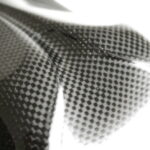Multiscale discontinuous composites could become widely used in the automotive industry and beyond. Dr Soraia Pimenta tells Simon Frost about research into these complex materials.
Multiscale discontinuous composites (MDCs) are a promising but problematic new family of materials. In their favour, they can be manufactured quickly and their high strength, stiffness and lightness could mean widespread application in high-volume applications. They could even compete with the composites used in aerospace. But this potential has not been harnessed, because we don’t know how to manipulate MDCs in design. In pursuit of a way to predict the behaviour of MDC structures, Dr Soraia Pimenta of Imperial College London has been awarded one of seven research fellowships granted by the Royal Academy of Engineering this year.
MDCs are a new type of composite material in which the reinforcement is composed of discontinuous fibre composites (DFCs) – randomly oriented bundles of carbon, recycled or natural fibres. Herein lies the problem. Dr Pimenta explains, ‘The architecture of discontinuous fibres is extremely complex and completely different to that of conventional composites. At the moment, there are virtually no methods to design structural components with these new composites, and that’s precisely what I’m hoping to change in the next five years.’ Predicting the materials’ response to mechanical loading and other forces has, until now, been on an experimental trial-and-error basis, which also makes the design process prohibitively expensive. ‘We are limited in the shape of components we can manufacture – these materials are already being used in some applications, but only in very conservative structures,’ she adds.
Dr Pimenta will lead the Academy-funded research beginning in January 2015, building on a year of experimental mechanical analysis and mathematical models examining the stiffness properties of the materials. She views the automotive industry as the major market for MDCs. ‘I think these are the first type of composites that can be used in such a high-volume industry,’ she says, ‘but the entire design process for a car typically needs to be completed within one year, so it is vital to have robust design methods that reduce the time. It takes much longer than it should do.’
Other research fellowships granted by the Royal Academy this year include studies of materials for use in nuclear reactors, the next generation of prosthetic limbs and the development of optical fibres for increasing data demands.
For more information, click here.











